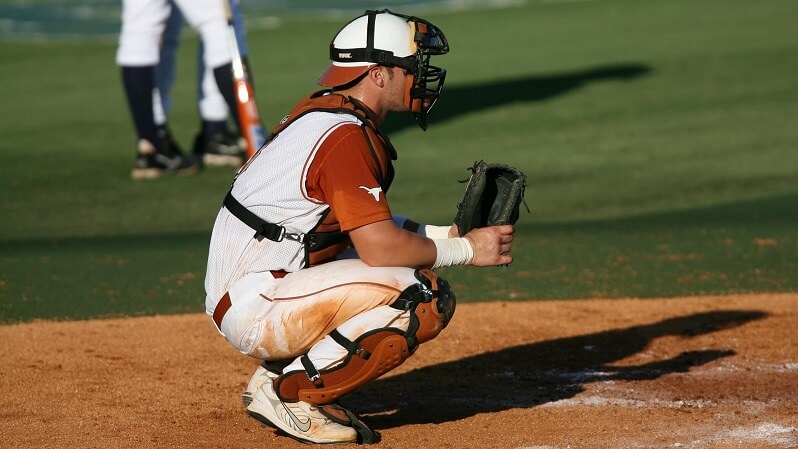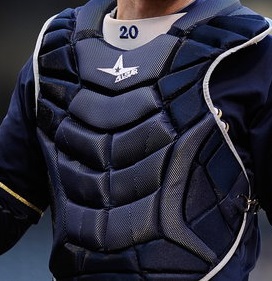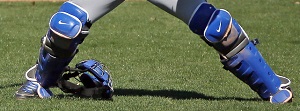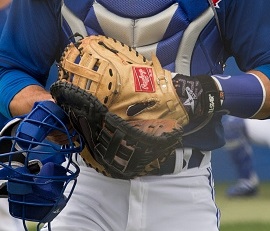
Picking the right catcher’s equipment is as important if not more so than any other player in the game.
While players in the outfield don’t see as much action as the players infield on a hit by hit basis, the catcher sees action with every single pitch, making the catcher one of the most dangerous AND well protected positions in the game. While there are chest protectors, leg guards (Shin guards), the mask, and of course the mitt, , what exactly do you need to be looking for in these pieces of equipment to insure you are in the best possible state for protection and playability? There’s no sense wearing equipment that doesn’t work, and even less sense if you can’t play in equipment that does. So we are going to break down what to look for in each piece of the equipment.
Chest Protector

While the chest protector is usually just a pull over vest padded heavily with rubber, leather, foams or gels, finding one that fits well and is sturdy enough to stop a 90 mph pitch without breaking ribs is another thing all together.
When picking your chest protector, make sure to check the weight and the fit or size as well. Too much weight or bad sizing can make the difference between being able to scoop a bad pitch and end a play to fumbling around and looking like an amateur. Also try to find one that extends to cover your non-throwing shoulder (your glove hand), while this isn’t necessary, if you have ever taken a pitch to the shoulder, you know it’s nice to have a little extra protection and not need it, than to take the hit when it could have been prevented. This page takes a look at the best choices one could make when looking for chest protection.
Leg Guards

While it seems that a solid plastic with foam backed leg “Armour” seems to be the usual type, insuring the straps fit snugly behind and just below the knee, and just above the ankle, will make sure they don’t ride or slip when you are on the move. While the leg guard is still referred to as the spike guard by some, knowing why it has this secondary name is important in knowing what to look for.
When runners come in hot with “spikes up” the last thing you want is for those spikes to tear through your pants and shins, or even the tops of your feet. This intimidation move by runners is why the leg guard is so thick, solid, and in a good pair, covers the tops of the feet too. If you get a chance when you try them on, give them a couple of whacks with your bat, start softly, and see if they can handle the force of a runner coming in hot.
If they seem to be sturdy enough, and they don’t slip when moving, these are the ones you want. Additionally, a little extra called Knee Savers, can be added in as well. It’s a special pad filled with air that helps you save your knee ligaments in the squatting position. It attaches to your guard straps and sits just under the back of the knee, giving you just a little extra support where you are going to need it. This leg guards page outlines our opinions on the top choices if you are interested.
Catchers Mask

Like all major league sports, the head is one of the most valuable parts on a player, and millions of dollars goes into designing and testing the gear that you will use.
While the original style of catcher’s mask was akin to a wire mesh cookie rack sitting on top of a round piece of leather covered foam and then shoe laced to the head of the catcher, newer styles have prevailed, and some have even started to look like hockey goalie masks. While the look is not as important as the fit and protection, a couple of things you should be looking for are adequate facial coverage, nose clearance, throat protection and a section that protects the top of the head from glancing blows from a bounced or ticked ball, and a poorly swung bat. You also have to insure there is no visibility obstruction, there is no point being safe if you can’t see the ball.
You can view our masks section to see the top choices for this year.
Catchers Mitt

The catcher’s mitt is very well padded, I am sure you can imagine why. What you need to look for to insure you have the best protection starts with the fit. While it would be nice to just grab a generic size and run out to play, ideally you want to test your new mitt.
Nothing tells you how well a mitt will protect you like taking a few dozen speedballs and seeing if you notice any pain or stinging. If you already have the mitt though, and it’s not quite cutting it, don’t worry, there is still another option for you. You can thicken things up by wearing an inner protective glove, while most just wear an average batting glove inside the mitt, anything that will fit is fair, and if it saves your hand, it’s totally worth it.
If you are interested in learning more, come check out the mitts area of our website.
Comments are closed.